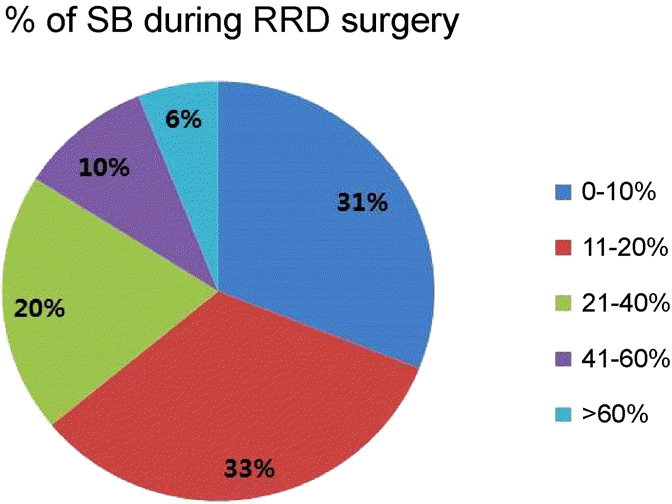Abstract
Purpose
To report the results of the 2015 questionnaire survey of current trends and practice patterns in the treatment of vitreoretinal diseases, which was conducted by the Korean Retina Society (KRS).
Methods
In October 2015, members of the KRS participated in a survey of current trends and practice patterns in the treatment of vitreoretinal diseases. This survey was comprised of 68 multiple choice and dichotomy questions.
Results
One hundred eleven (41%) members participated in this survey. Most respondents (42%) had begun their vitreoretinal subspecialty ≤7 years previously, 32% had practiced for 8–15 years, and 26% for 16 years or more. The preferred primary treatment for newly diagnosed wet-type age-related macular degeneration was ranibizumab or aflibercept, and most clinicians (68%) favored a pro re nata regimen. Seventy percent of respondents treated injection-related endophthalmitis using a combination of immediate vitrectomy and intravitreal antibiotic injection. Bevacizumab was the most commonly (78–87%) preferred first-line therapy for macular edema (ME) secondary to central retinal vein occlusion or branch retinal vein occlusion. When ME did not respond to anti-vascular endothelial growth factor treatment, most respondents (91%) switched patients to dexamethasone implant or triamcinolone acetonide. Eighty-four percent of the respondents performed scleral buckling during retinal detachment surgery in fewer than 40% of cases. Also, most respondents (96%) prescribed an antibiotic eye drop after, or before and after intravitreal drug injection.
Go to : 
References
1. Sigler EJ, Randolph JC, Charles S, Calzada JI. Intravitreal fluori-nated gas preference and occurrence of rare ischemic postoperative complications after pars plana vitrectomy: a survey of the american society of retina specialists. J Ophthalmol. 2012; 2012:230596.

2. Yoon SC, Jung JW, Sohn HJ, Shyn KH. Cataract and refractive abdominal in; a survey of KSCRS members from 1995∼2006. Korean J Ophthalmol. 2009; 23:142–7.
3. Wi JM, Moon HS, Kim KH, Shyn KH. 2012 Survey of KSCRS and KOS member: current trends in cataract surgery in Korea. J Korean Ophthalmol Soc. 2015; 56:1181–7.

4. Cho GE, Kim SW, Kang SW; Korean Retina Society. Changing trends in surgery for retinal detachment in Korea. Korean J Ophthalmol. 2014; 28:451–9.
5. Nozaki M, Suzuma K, Inoue M, et al. Preference and trends of treatment for diabetic retinopathy in Korea and Japan. Nippon Ganka Gakkai Zasshi. 2013; 117:735–42.
6. Koizumi H, Kano M, Yamamoto A, et al. Aflibercept therapy for polypoidal choroidal vasculopathy: short-term results of a abdominal study. Br J Ophthalmol. 2015; 99:1284–8.
7. Yamamoto A, Okada AA, Kano M, et al. One-year results of abdominal aflibercept for polypoidal choroidal vasculopathy. Ophthalmology. 2015; 122:1866–72.
8. Korobelnik JF, Do DV, Schmidt-Erfurth U, et al. Intravitreal abdominal for diabetic macular edema. Ophthalmology. 2014; 121:2247–54.
Go to : 
 | Figure 1.Preferred treatments for naïve choroidal neovascularization (CNV). (A) Ranibizumab is the most selected for wet-type age-related macular degeneration (wAMD)-CNV. (B) Aflibercept is the most preferred for wAMD-polypoidal choroidal vasculopathy. (C) Bevacizumab is most used drug for the idiopathic CNV. PCV = polypoidal choroidal vasculopathy; PDT = photodynamic therapy; VEGF = vascular endothelial growth factor. |
 | Figure 2.Preferred treatment strategy after initial management. (A, B) The pro re nata (PRN) protocol was the most preferred in the treatment of wet-type age-related macular degeneration (wAMD) and macular edema (ME) secondary to branch retinal vein occlusion (BRVO). T & E = treat and extend. |
 | Figure 3.Preferred treatments for macular edema (ME) secondary to retinal vein occlusion. (A, B) Bevacizumab is the most selected drug for ME secondary to central retinal vein occlusion (CRVO) or branch retinal vein occlusion (BRVO). |
 | Figure 4.Preferred treatments for diabetic macular edema (DME) and vitreous hemorrhage (VH) secondary to proliferative diabetic retinopathy (PDR). (A) Most respondents (88%) switched the treatment option after 2–3 anti-vascular endothelial growth factor (VEGF) injections. (B) In patient with VH secondary to PDR without traction or retinal detachment (RD), half of respondents observed and considered pars plana vitrectomy (PPV) or laser photocoagulation, and a quarter performed immediate anti-VEGF injection. |
 | Figure 5.Primary surgical options for the management of pseudophakic and macular-sparing retinal detachment (RD). (A) Fifty-seven percent of respondents performed the pars plana vitrectomy (PPV) with gas or silicone oil (SO) tamponade, and 32% only conducted the in patients with superior rhegmatogenous retinal detachment (RRD) with flap tear. (B) Half of the respondents performed scleral buckling (SB) only, and 35% carried out PPV with gas or SO tamponade in cases with inferior RRD with retinal tear. |




 PDF
PDF ePub
ePub Citation
Citation Print
Print



 XML Download
XML Download